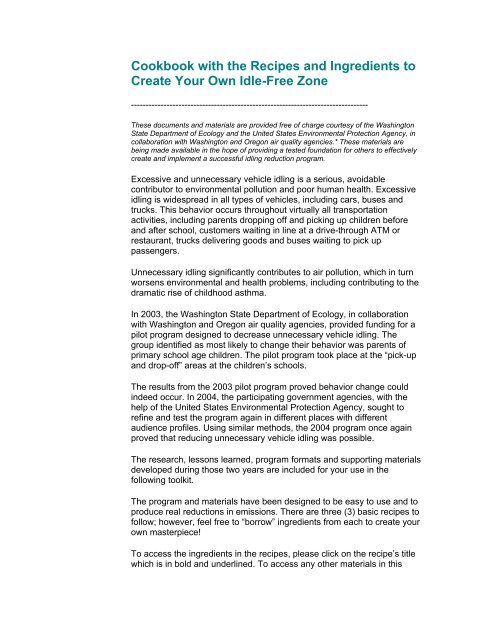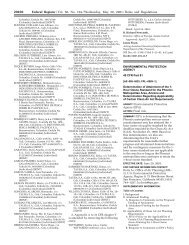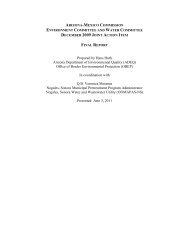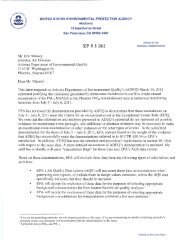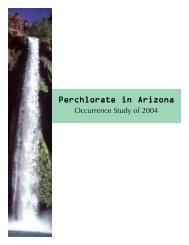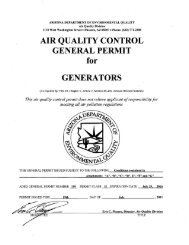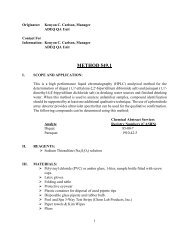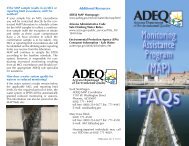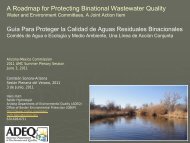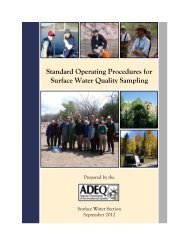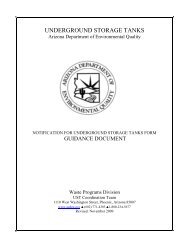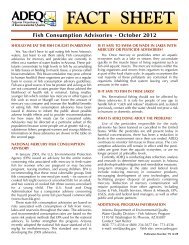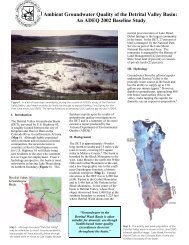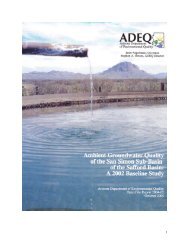Cookbook with Recipes and Ingredients to Create Your Own Idle ...
Cookbook with Recipes and Ingredients to Create Your Own Idle ...
Cookbook with Recipes and Ingredients to Create Your Own Idle ...
- No tags were found...
You also want an ePaper? Increase the reach of your titles
YUMPU automatically turns print PDFs into web optimized ePapers that Google loves.
<strong>Cookbook</strong> <strong>with</strong> the <strong>Recipes</strong> <strong>and</strong> <strong>Ingredients</strong> <strong>to</strong><strong>Create</strong> <strong>Your</strong> <strong>Own</strong> <strong>Idle</strong>-Free Zone--------------------------------------------------------------------------------These documents <strong>and</strong> materials are provided free of charge courtesy of the Washing<strong>to</strong>nState Department of Ecology <strong>and</strong> the United States Environmental Protection Agency, incollaboration <strong>with</strong> Washing<strong>to</strong>n <strong>and</strong> Oregon air quality agencies.* These materials arebeing made available in the hope of providing a tested foundation for others <strong>to</strong> effectivelycreate <strong>and</strong> implement a successful idling reduction program.Excessive <strong>and</strong> unnecessary vehicle idling is a serious, avoidablecontribu<strong>to</strong>r <strong>to</strong> environmental pollution <strong>and</strong> poor human health. Excessiveidling is widespread in all types of vehicles, including cars, buses <strong>and</strong>trucks. This behavior occurs throughout virtually all transportationactivities, including parents dropping off <strong>and</strong> picking up children before<strong>and</strong> after school, cus<strong>to</strong>mers waiting in line at a drive-through ATM orrestaurant, trucks delivering goods <strong>and</strong> buses waiting <strong>to</strong> pick uppassengers.Unnecessary idling significantly contributes <strong>to</strong> air pollution, which in turnworsens environmental <strong>and</strong> health problems, including contributing <strong>to</strong> thedramatic rise of childhood asthma.In 2003, the Washing<strong>to</strong>n State Department of Ecology, in collaboration<strong>with</strong> Washing<strong>to</strong>n <strong>and</strong> Oregon air quality agencies, provided funding for apilot program designed <strong>to</strong> decrease unnecessary vehicle idling. Thegroup identified as most likely <strong>to</strong> change their behavior was parents ofprimary school age children. The pilot program <strong>to</strong>ok place at the “pick-up<strong>and</strong> drop-off” areas at the children’s schools.The results from the 2003 pilot program proved behavior change couldindeed occur. In 2004, the participating government agencies, <strong>with</strong> thehelp of the United States Environmental Protection Agency, sought <strong>to</strong>refine <strong>and</strong> test the program again in different places <strong>with</strong> differentaudience profiles. Using similar methods, the 2004 program once againproved that reducing unnecessary vehicle idling was possible.The research, lessons learned, program formats <strong>and</strong> supporting materialsdeveloped during those two years are included for your use in thefollowing <strong>to</strong>olkit.The program <strong>and</strong> materials have been designed <strong>to</strong> be easy <strong>to</strong> use <strong>and</strong> <strong>to</strong>produce real reductions in emissions. There are three (3) basic recipes <strong>to</strong>follow; however, feel free <strong>to</strong> “borrow” ingredients from each <strong>to</strong> create yourown masterpiece!To access the ingredients in the recipes, please click on the recipe’s titlewhich is in bold <strong>and</strong> underlined. To access any other materials in this
When the students bring back the signed pledge form, the teacher h<strong>and</strong>sthem another envelope which contains an idling reduction key chain (seeindex for example) or other idling reduction incentive, as well as adiscount coupon from a participating local merchant.Each participating schoolteacher is briefed on the program through aletter that clearly outlines the process <strong>and</strong> goals of the program. If apredetermined number of students in a classroom (past programs haveused a goal of an 80 percent response rate) return a signed pledge form,then the classroom will earn a reward such as a pizza or ice cream party.Teachers in classrooms meeting the goal will also receive an award suchas a coffee shop gift card or movie tickets.In addition <strong>to</strong> outreach efforts <strong>to</strong> students <strong>and</strong> parents, idling reductionsigns are posted in the drop-off/pick-up area(s) of the school (see indexfor example). These signs help <strong>to</strong> spread the idling reduction message<strong>and</strong> serve as a reminder for parents <strong>and</strong> guardians <strong>to</strong> turn off their vehiclewhile dropping off <strong>and</strong> picking up students.Delivery Driver OutreachThe front office staff at the school is asked <strong>to</strong> provide idling reductionmaterials <strong>to</strong> delivery drivers (mail, food, supplies) who frequent theschool. The delivery drivers are asked <strong>to</strong> sign an idling reduction pledgeform. When the driver returns a signed pledge form, they receive a thankyou letter, idling reduction key chain or other messaging/incentive <strong>to</strong>ol,<strong>and</strong> a discount coupon from a participating local merchant. (Click onrecipe title or see index for sample templates.)Bus Driver OutreachTo further exp<strong>and</strong> the idling reduction message, idling reduction factsheets <strong>and</strong> pledge forms are sent <strong>to</strong> the transportation direc<strong>to</strong>r whooversees the school district’s bus drivers. Bus drivers are asked <strong>to</strong> signthe idling reduction pledge. If they return a signed pledge, they willreceive a thank you letter, idling reduction key chain or other messaging<strong>to</strong>ol, <strong>and</strong> a discount coupon from a participating local merchant. (Click onrecipe title or see index for sample templates.) Sample language is alsoprovided for those schools or bus companies that do not currently havewritten idling reduction policies.Measuring Idling LevelsVolunteers or temporary staff will need <strong>to</strong> be recruited <strong>to</strong> measure vehicleidling times during the course of the program. These “research staff” willuse a form (click on recipe title or see index for sample templates) <strong>to</strong> trackhow long parents (not buses or delivery drivers) idle their cars whiledropping off or picking up students. Research staff will also be asked <strong>to</strong>record weather conditions, the type of vehicle idling (e.g., passenger car,
SUV, mini-van), <strong>and</strong> any other notable fac<strong>to</strong>rs such as whether anyoneelse is in the vehicle.Copies of the tracking form, clipboards, pens <strong>and</strong> s<strong>to</strong>pwatches should beprovided for use during the program <strong>and</strong> left <strong>with</strong> the school’s front officestaff. Research staff will be asked <strong>to</strong> check in <strong>with</strong> the school’s front desk<strong>to</strong> pick up <strong>and</strong> drop off their supplies.Phase 1: Before the classroom notices go home, two <strong>to</strong> three moni<strong>to</strong>rstrack idling behavior for five days.Phase 2: After the classroom notices are returned, two <strong>to</strong> three moni<strong>to</strong>rstrack idling behavior for five days.Following the conclusion of the second five-day time period (i.e.,information has gone home <strong>to</strong> parents, signs are installed, etc.),evaluation teams return <strong>to</strong> the school <strong>to</strong> record <strong>and</strong> observe the idlingbehavior for five more consecutive days <strong>to</strong> see if your efforts had aneffect on behavior.The advantage <strong>to</strong> this method is that it includes a “before <strong>and</strong> after”snapshot at one school. A potential drawback <strong>to</strong> this method is thepossibility of a dramatic change in weather, which can influence idlingbehaviors <strong>and</strong> affect your results.Full-SizeA detailed description of the Full-Size Plan is listed below. Main“ingredients” of the program are as follows:oooooooooFive-day program - targeting classrooms, bus drivers & deliverydriversControl <strong>and</strong> participating schoolsMoni<strong>to</strong>ring/Data collectionThird party partnersSignageIdling fact sheets, pledge forms, measurement formsMedia templatesThank you <strong>and</strong> incentives such as key chainsPublished resultsIn this scenario, two similarly sized <strong>and</strong> located schools <strong>with</strong>in a schooldistrict are recruited. One school will act as the control school (a schoolthat does not receive the anti-idling materials), <strong>and</strong> the other as theparticipating school. The suggested duration for the moni<strong>to</strong>ring is fiveconsecutive days.
Control School OutreachAt the control school, idling behavior is not influenced. However, duringthe course of the moni<strong>to</strong>ring, idling behavior is observed <strong>and</strong> recorded. Itis essential <strong>to</strong> observe <strong>and</strong> record data during afternoon pick-up times. Ifresources are available, it is also preferred, but not essential, <strong>to</strong> observe<strong>and</strong> record idling behavior during student drop-off times in the morning.Participating School OutreachThe second school is designated as the participating school. Parents ofchildren at the participating school receive idling reduction packetscontaining a letter about the program, fact sheet, <strong>and</strong> pledge forms.These materials are sent home <strong>with</strong> the students the week prior <strong>to</strong> theprogram dates. Parents <strong>and</strong> students are asked <strong>to</strong> read the idlingreduction message, <strong>and</strong> sign <strong>and</strong> return the pledge forms. (Click onrecipe title or see index for sample templates.)When the students bring back the signed pledge form, the teacher h<strong>and</strong>sthem another envelope which contains an idling reduction key chain (seeindex for example) or other idling reduction incentive, as well as adiscount coupon from a participating local merchant.Each participating school teacher is briefed on the program through aletter that clearly outlines the process <strong>and</strong> objectives of the program. If apredetermined number of students in the classroom (past programs haveused a goal of an 80 percent response rate) return a signed pledge form,then the classroom will earn a reward such as a pizza or ice cream party.Teachers in classrooms meeting the predetermined goal will also receivean award such as a coffee shop gift card or movie tickets.In addition <strong>to</strong> outreach efforts <strong>to</strong> students <strong>and</strong> parents, idling reductionsigns are posted in the drop-off/pick-up area(s) of the school (see indexfor example). These signs help <strong>to</strong> spread the idling reduction message<strong>and</strong> serve as a reminder for parents <strong>and</strong> guardians <strong>to</strong> turn off their vehiclewhile dropping off <strong>and</strong> picking up students.Delivery Driver OutreachThe front office staff at the participating school is also asked <strong>to</strong> providedelivery drivers who frequent the school (e.g., mail services <strong>and</strong> food <strong>and</strong>supply providers) <strong>with</strong> idling reduction materials. The delivery drivers areasked <strong>to</strong> sign an idling reduction pledge form. When the driver returns asigned pledge form, they receive a thank you letter, idling reduction keychain or other messaging/incentive <strong>to</strong>ol, <strong>and</strong> a discount coupon from aparticipating local merchant. (Click on recipe title or see index for sampletemplates.)
Bus Driver OutreachTo further exp<strong>and</strong> the idling reduction message, idling reduction factsheets <strong>and</strong> pledge forms are sent <strong>to</strong> the transportation direc<strong>to</strong>r whooversees the school district’s bus drivers. Bus drivers are asked <strong>to</strong> signthe idling reduction pledge. If they return a signed pledge, they willreceive a thank you letter, idling reduction key chain or other messaging<strong>to</strong>ol, <strong>and</strong> a discount coupon from a participating local merchant. (Click onrecipe title or see index for sample templates.) Sample language is alsoprovided for those schools or bus companies that do not currently havewritten idling reduction policies.Measuring Idling LevelsVolunteers or temporary staff will need <strong>to</strong> be recruited <strong>to</strong> measure vehicleidling times during the course of the program for both the control <strong>and</strong>participating schools. Research staff will use a measurement form (clickon recipe title or see index for sample templates) <strong>to</strong> track how longparents (not buses or delivery drivers) idle their cars while dropping off orpicking up students. Research staff will also be asked <strong>to</strong> record weatherconditions, the type of vehicle idling, <strong>and</strong> any other notable fac<strong>to</strong>rs.Copies of the measurement form, clipboards, pens <strong>and</strong> s<strong>to</strong>pwatchesshould be provided for use during the program <strong>and</strong> sent <strong>to</strong> the front officestaff for the school. Research staff or volunteers will be asked <strong>to</strong> check in<strong>with</strong> the school’s front desk <strong>to</strong> pick up <strong>and</strong> drop off their supplies.*These materials may be reproduced <strong>and</strong> distributed <strong>with</strong>out charge.However, it is forbidden for these materials <strong>to</strong> be used in any way forcommercial purposes <strong>with</strong>out express written permission from theWashing<strong>to</strong>n State Department of Ecology.By using any information or materials contained herein, you accept full<strong>and</strong> complete responsibility for any <strong>and</strong> all actions, claims, damages,costs, expenses or liabilities, including reasonable at<strong>to</strong>rneys’ fees thatmight arise.


